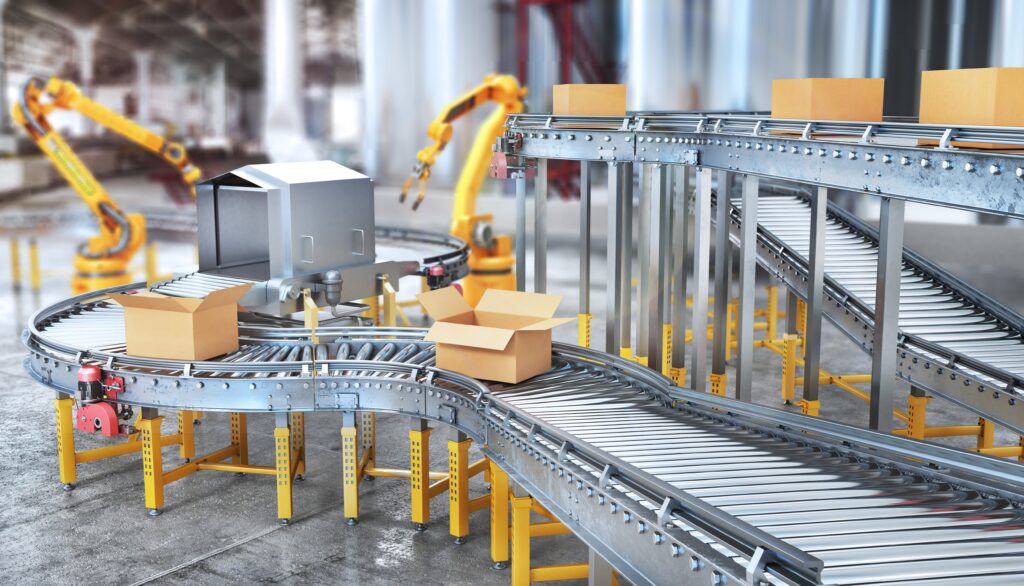Warehouse automation companies are experiencing rapid growth. This is driven by concerns around cost and availability of labour, and particularly the shift in route-to-market towards online purchasing. Online fulfilment means lots of small orders and, while there are ways of optimising a manual operation to do this, once a certain scale is reached, the case for automated material handling becomes very strong.
What is a sortation system?
There is much fanfare around innovative warehouse automation solutions. Conveyor systems and sorters are pieces of equipment that have been around for a very long time. Almost all automated solutions will feature conveyors somewhere in the design.
Sortation systems reduce the manual labour needed to prepare for palletizing, packing and shipping. Efficient sortation can increase order fill rates, minimize returns and reduce operating costs. These benefits mean lower prices and faster delivery to the customer.
Most automated sortation systems use a fixed-position bar code scanner. The scanner identifies each carton or item on the conveyor and sends that information to the system controls. The destination of each product is pre-programmed and activates the sortation mechanism when the product arrives at its designated divert point.
Types of high-speed sortation systems
There are many ways to sort items as they move through the warehouse. Sortation solutions range from basic manual pushers and diverters to sophisticated high-speed sorters that can handle as many as 450 items per minute. The right sortation solution depends on the items you are moving, and the urgency required. When speed is of the essence, these methods of automated solutions are your options:
Wave sorters
Wave sorters are flexible solutions used for parcels, books, and envelope-sealed items. A roller-swivelling system enables rapid sorting of large and small articles.
Cross-belt and bomb-bay sorters
Bomb-bay sorters drop their contents flat at the desired sort location through a false bottom in the tray, into a box/tote or chute. Gravity is the power source.
Cross-belts trigger a conveyor within the tray to fire the item off down a chute. Cross-belt sorters are versatile and used extensively to sort parcel orders and small items that may be difficult to sort at high speed, such as fragile or high friction items. There is a high demand for these sorters in the e-commerce sector.
Bomb-bay sorters are typically used to sort individual items to workstations such as packing stations or returns processing stations. They are preferred when sorting items for shipping to many destinations.
Autonomous Mobile Robots (AMRs)

Autonomous Mobile Robots (AMRs) are a quite new alternative to fixed sortation technologies. Usually the AMRs have complex sensors that allow them to understand and interpret their environment. This helps them to perform their tasks in the most effective approach, which makes them even more capable of working with humans in activities like picking, checking, or packing an order.
Sliding shoe sorters
A sliding shoe sorter consists of a bed of aluminium slats with shoes attached. This type of solution boasts high throughput with accurate movement. Instead of being configured in a loop, a sliding shoe sorter is linear: products enter at the beginning of the line and are diverted before they reach the end of the line. They can be more expensive than other solutions because they run at variable speeds and are a good choice for fragile items. Sliding shoe sorters can handle larger cartons and totes.
Hanging and pocket sorters
A hanging garment sorter is traditionally used to sequence garments in size order on rails for automated picking. An innovative use of this system is to use pockets to hold general merchandise products within a hanging garment sorter structure – this is proving very popular for large e-commerce and omnichannel fulfilment centres.
Sortation solutions in practice
Most e-commerce operations direct the picked or sorted order to packing benches where a person packs the products, and the parcel is taken away by conveyor. This is where the simpler end of sortation is often seen: wave sorters or shoe sorters to direct the parcels to the correct carrier vehicle. The selection of items to fulfil orders is a core function in most warehouses and, depending on the order profile, there are many solutions available. In environments with a high number of SKUs, where orders consist of multiple order lines and items, the travel time of pickers is a major concern. This process can be made more efficient through batch picking and automating the sortation.
Not every facility needs to move product at rapid rates. Slower-speed pusher sortation systems work in conjunction with standard belt or roller conveyor lines and typically handle fewer than 30 cartons or totes per minute. These affordable options are energy-efficient, involve less movement and are quieter in operation.
Trends in sortation solutions
- More innovative automated equipment will be needed to cope with the trend towards smaller shipments and more frequent, single parcels.
- There will be an on-going quest for higher speeds with equivalent high accuracy
- Reduction of sound levels in automated sorters
- More flexibility and adaptability in new innovations
Engaging with equipment vendors in an unstructured way can leave you with more questions than answers. Based on the clients’ requirements, SCCG will always understand what businesses try to achieve and will undertake a cost/benefit analysis to consider the best automation solutions that need to be applied for the best warehouse solutions.














